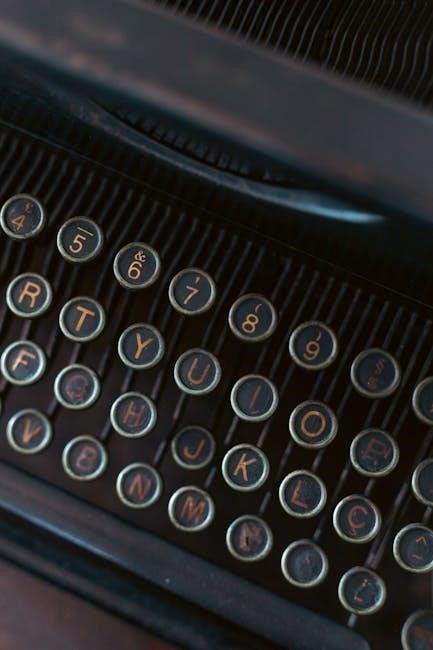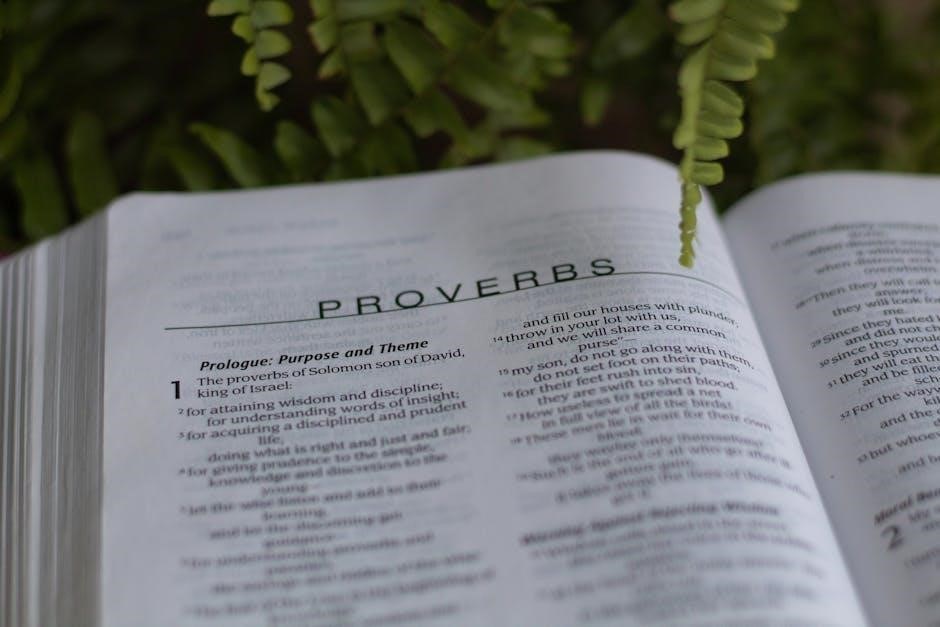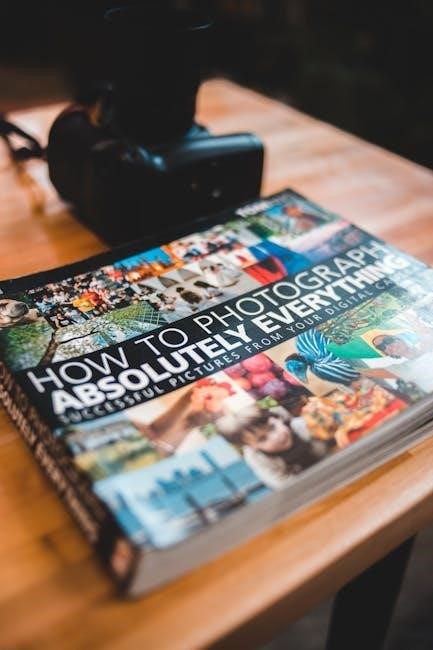plantronics voyager 5200 manual pdf
Welcome to the Plantronics Voyager 5200 manual, your comprehensive guide to understanding and optimizing your headset. This manual covers setup, features, and troubleshooting for seamless functionality.
1.1 Overview of the Plantronics Voyager 5200 Headset
The Plantronics Voyager 5200 is a high-performance Bluetooth headset designed for seamless communication. It offers advanced noise cancellation, long battery life, and intuitive controls. Perfect for mobile professionals, it ensures crystal-clear audio in any environment. The headset is lightweight, durable, and built for all-day comfort. With voice prompts and LED indicators, it simplifies pairing and battery monitoring. Its sleek design and robust features make it an ideal choice for both office and on-the-go use, providing reliable connectivity and superior sound quality.
1.2 Importance of Reading the Manual
Reading the Plantronics Voyager 5200 manual is essential for maximizing your headset’s potential. It provides detailed instructions for setup, pairing, and troubleshooting, ensuring optimal performance. The manual explains advanced features like noise cancellation and battery management, helping you customize settings for a personalized experience. By understanding proper usage and maintenance, you can extend the headset’s lifespan and resolve common issues quickly. This guide serves as your roadmap to unlocking all the benefits of your Voyager 5200, ensuring you enjoy uninterrupted, high-quality audio and reliable connectivity.

Headset Overview and Components
The Plantronics Voyager 5200 is a sleek, lightweight Bluetooth headset designed for comfort and functionality. It features advanced noise cancellation, long battery life, and intuitive controls for seamless call management and audio playback.
2.1 Key Features of the Voyager 5200
The Voyager 5200 boasts advanced noise-cancellation technology, ensuring clear audio in noisy environments. It features a lightweight design, long-lasting battery life, and seamless Bluetooth connectivity. The headset supports voice commands, mute functionality, and intuitive call management. Additionally, it integrates with the Plantronics Hub app for customizable settings and firmware updates. Its sleek, ergonomic design ensures all-day comfort, making it ideal for professionals seeking a reliable, high-performance headset for calls and multimedia use.
2.2 Physical Description and Controls
The Voyager 5200 is a lightweight Bluetooth headset weighing approximately 20 grams, designed for comfort and portability. It features a sleek, ergonomic design with a microphone boom for enhanced call clarity. The headset includes intuitive controls such as a call button, volume adjusters, and a mute button for easy operation. LED indicators provide visual feedback for battery status, pairing, and mute functionality. The design ensures a secure fit with interchangeable ear tips, catering to different preferences. Its compact form factor makes it easy to carry and use on the go, blending style with functionality for professional and everyday use.

Safety Precautions and Guidelines
Adhere to safety guidelines to ensure optimal performance and longevity. Avoid extreme temperatures, use original chargers, and handle the headset with care to prevent damage and ensure reliability.
3.1 General Safety Information
Ensure safe usage of your Plantronics Voyager 5200 by following essential guidelines. Avoid exposing the headset to extreme temperatures or moisture, as this may damage the device. Use only original Plantronics chargers to prevent battery issues. Handle the headset with care to maintain its durability. Keep it out of reach of children and avoid using it in hazardous environments. Regularly inspect the product for damage and store it properly when not in use. Adhere to these precautions to ensure optimal performance and longevity of your headset.
- Avoid extreme temperatures and moisture.
- Use original Plantronics chargers only.
- Handle the headset with care.
- Store properly when not in use.
By following these guidelines, you can ensure safe and reliable operation of your Voyager 5200 headset.
3.2 Proper Handling and Usage
Handle your Plantronics Voyager 5200 with care to maintain its performance. Clean the headset regularly with a soft cloth and avoid harsh chemicals. Store it in a protective case when not in use. Use the headset in environments with temperatures between 32°F and 104°F (0°C to 40°C) for optimal functionality. Avoid exposing it to direct sunlight or moisture. For proper usage, ensure the headset is securely fitted and adjust settings using the controls gently. Regularly inspect for damage and follow the manual’s guidelines for troubleshooting and maintenance.
Proper care ensures longevity and reliable performance.
Charging the Headset
The Voyager 5200 charges via micro-USB. Connect it to a power source and allow 1-2 hours for a full charge. LED indicators show charging status.
4.1 How to Charge the Voyager 5200
To charge the Voyager 5200, connect the micro-USB cable to the headset and the other end to a USB port or wall adapter. The LED indicator will glow red during charging and turn blue once fully charged, which typically takes 1-2 hours. Ensure the headset is powered off for the fastest charging. Avoid overcharging to maintain battery health. Use only Plantronics-approved chargers to prevent damage. The headset can also be charged via a USB port on your computer or a certified charging device for convenience.
4.2 Checking Battery Level
To monitor the Voyager 5200’s battery life, you can use multiple methods. Press the Call button to hear voice prompts indicating the remaining battery percentage. The LED indicator on the headset also provides visual feedback: a steady blue light means a full charge, while a red light signals low battery. Additionally, the Plantronics Hub app for desktop or mobile allows you to check the battery level and receive notifications when it’s time to recharge. These features ensure you stay informed and never run out of power unexpectedly.
Pairing the Headset with Devices
Pairing your Voyager 5200 with devices is straightforward. It supports connections to mobile phones, computers, and desk phones. Follow the manual’s step-by-step guide for seamless pairing.
5.1 Pairing with Mobile Phones
To pair your Voyager 5200 with a mobile phone, ensure Bluetooth is enabled on your device. Place the headset in pairing mode by holding the call button until the LED flashes red and blue. Open your phone’s Bluetooth settings and select “Plantronics Voyager 5200” from the available devices. Follow the on-screen prompts to complete the pairing process. Once connected, you’ll hear a confirmation tone. Ensure your phone and headset are fully charged for a stable connection. If pairing fails, restart both devices and try again.
5.2 Pairing with Computers and Desktops
To pair your Voyager 5200 with a computer or desktop, enable Bluetooth on your device. Activate pairing mode on the headset by holding the call button until the LED flashes red and blue. Open your computer’s Bluetooth settings, select “Plantronics Voyager 5200” from the list of available devices, and follow the on-screen instructions to complete the pairing. Once connected, you’ll hear a confirmation tone. For a stable connection, ensure both devices are fully charged. If pairing fails, restart your computer and headset, then retry the process.
5.3 Pairing with Desk Phones
To pair your Voyager 5200 with a desk phone, ensure your phone supports Bluetooth or has a Bluetooth adapter. Turn on the headset and press the call button until the LED flashes red and blue to enter pairing mode. On your desk phone, navigate to the Bluetooth settings and select “Plantronics Voyager 5200” from the available devices; If prompted, confirm the pairing on both devices. Once connected, test the audio by making a call. For non-Bluetooth desk phones, use a compatible Bluetooth adapter, following its pairing instructions. Ensure the headset is fully charged before pairing for optimal performance.
Controlling Calls and Audio
Manage calls with intuitive controls: answer/end calls, adjust volume, and mute. Control audio playback with play/pause and track navigation for a seamless experience.
6.1 Answering and Ending Calls
To answer a call on the Voyager 5200, press the Call button located on the headset. The LED indicator will flash blue to confirm the call is connected. To end a call, press the Call button again until you hear a tone, and the LED will stop flashing. For incoming calls, a single press answers, while a press-and-hold can reject the call. Use voice commands for hands-free control, such as saying “Answer” or “Ignore” to manage calls effortlessly. Ensure the headset is properly paired and charged for reliable call handling.
6.2 Adjusting Volume and Muting
Adjust the volume on your Voyager 5200 by using the + and ー buttons on the headset. Press the + button to increase volume and the ー button to decrease it. For muting, press and hold the Mute button until the LED flashes red, indicating mute is active. To unmute, press and hold the Mute button again. Ensure the headset is paired to your device and audio is playing before adjusting settings. Use these controls to personalize your call and audio experience for optimal comfort and clarity during use.
6.3 Managing Play/Pause and Track Control
Manage audio playback on your Voyager 5200 using the Call button. Press once to play or pause music. Double-tap to skip to the next track and triple-tap to go back. The LED will flash blue when controlling music. For voice prompts, press and hold the Call button. Use these controls seamlessly while paired to your device. Ensure the headset is connected via Bluetooth or wired connection for optimal functionality. This feature enhances your multimedia experience, allowing easy track navigation without needing your device. Explore these controls to streamline your audio management effortlessly.

Customizing Settings
Customize your Voyager 5200 experience through the Plantronics Hub desktop software, enabling adjustments like noise cancellation and audio settings for personalized sound. Additionally, integrate with the Tile app for tracking and Amazon Alexa for voice commands, enhancing functionality and convenience seamlessly.
7.1 Using Plantronics Hub for Desktop
Plantronics Hub for Desktop is a powerful software tool designed to enhance your Voyager 5200 experience. It allows you to customize settings such as noise cancellation, audio preferences, and call controls. With Plantronics Hub, you can also update firmware, monitor battery life, and personalize features like voice prompts and mute settings. Download the software from the official Plantronics website and install it on your Windows or Mac system. This platform provides a user-friendly interface to tailor your headset settings, ensuring optimal performance and a personalized experience. Regular updates via Plantronics Hub ensure your device stays up-to-date with the latest features and improvements, maximizing functionality and user satisfaction.
7.2 Integrating with the Tile App
Integrate your Plantronics Voyager 5200 with the Tile App to enhance tracking and management. Launch the Plantronics Hub desktop app, navigate to the “Third-Party Apps” section, and activate Tile. Once enabled, open the Tile App to pair your headset. This integration allows you to locate your headset on a map, receive notifications when it’s moved, and track its last known location. The Tile App provides an additional layer of security and convenience, ensuring your Voyager 5200 stays connected and easy to find, even in busy environments.
7.3 Setting Up Amazon Alexa
Enhance your Plantronics Voyager 5200 experience by integrating Amazon Alexa. Launch the Amazon Alexa app, enable the Plantronics skill, and follow the in-app instructions to link your headset. Once connected, you can use voice commands to access Alexa’s features, such as setting reminders, playing music, or receiving updates. Open the Plantronics Hub app, navigate to the “Third-Party Apps” menu, and activate Amazon Alexa to complete the setup. This integration allows hands-free interaction with Alexa, offering convenience and seamless multitasking while using your Voyager 5200 headset.

Audio Quality and Noise Cancellation
The Voyager 5200 delivers exceptional audio clarity with advanced noise cancellation, minimizing background interference for crisp calls and immersive listening experiences. Optimize settings for enhanced sound quality.
8.1 Understanding Noise Cancellation Features
The Plantronics Voyager 5200 incorporates advanced noise cancellation technology to ensure clear audio in noisy environments. Its dual-microphone system actively reduces background noise, capturing only your voice. Adaptive audio adjustments automatically optimize sound quality based on surroundings. Wind noise reduction further enhances call clarity outdoors. The headset also features passive noise isolation, minimizing ambient sounds during music or calls. These technologies work together to deliver consistent, high-quality audio, making it ideal for professionals in dynamic workspaces. By understanding these features, users can fully leverage the headset’s capabilities for uninterrupted communication and immersive listening experiences.
8.2 Optimizing Audio Quality
Enhance your audio experience with the Voyager 5200 by fine-tuning settings via the Plantronics Hub app. Adjust equalizer presets to customize sound preferences. Ensure proper fit for optimal noise isolation and audio clarity; Regularly update firmware to benefit from performance improvements. Enable noise cancellation during calls for clearer voice transmission. Use the mute button to eliminate background noise when speaking. For music, switch to audio mode to enjoy immersive sound. These adjustments ensure exceptional audio quality, whether for calls, music, or multimedia, providing a seamless listening experience tailored to your needs.

Troubleshooting Common Issues
Identify and resolve common problems like connectivity issues or audio distortion. Reset the headset, check battery levels, and ensure proper device pairing for optimal performance.
9.1 Resolving Connectivity Problems
If your Voyager 5200 experiences connectivity issues, restart your headset and ensure it is properly paired with your device. Check the Bluetooth settings on your phone, computer, or desk phone to confirm the connection. If problems persist, reset the headset by following the manufacturer’s instructions. Ensure your headset and device have sufficient battery life. Additionally, use the Plantronics Hub app to update firmware and verify connection settings. If issues remain, refer to the troubleshooting section in the manual for advanced solutions.
9.2 Fixing Audio Distortion or Dropouts
To address audio distortion or dropouts on your Plantronics Voyager 5200, first ensure a stable Bluetooth connection by moving closer to the paired device. Reduce interference from other wireless gadgets. Restart your headset and check for firmware updates via Plantronics Hub. Clean the earpieces gently with a soft cloth to remove debris. If issues persist, reset the headset to factory settings or contact customer support for assistance. Ensuring proper battery levels and checking for software updates can also help resolve audio quality problems effectively.
9.3 Resetting the Headset
To reset the Plantronics Voyager 5200, hold the Volume Down and Call buttons simultaneously for 10 seconds until the LED flashes red. Release the buttons and wait for the headset to power off. Press and hold the Power button to turn it back on. This process restores factory settings, clearing all paired devices and customizations. Note that resetting will erase all saved settings, so you’ll need to re-pair the headset with your devices afterward. Regular resets can help resolve persistent connectivity or audio issues effectively.

Maintenance and Care
Regularly clean the Voyager 5200 with a soft, dry cloth to prevent dirt buildup. Avoid liquids and harsh chemicals. Store it in the provided case to protect against damage. For long-term storage, keep the battery charged to prevent deep discharge. Avoid extreme temperatures to maintain performance and longevity. Update firmware via Plantronics Hub for optimal functionality.
10.1 Cleaning the Headset
Regular cleaning ensures optimal performance and longevity. Use a soft, dry cloth to wipe the headset, paying attention to the ear cushions and microphone. Avoid using liquids, chemicals, or abrasive materials, as they may damage the finish or internal components. For stubborn stains, lightly dampen the cloth with water, but ensure no moisture enters the headset. Do not submerge any part in water. Clean the controls and charging contacts with a dry cloth to maintain proper connectivity. Regularly sanitizing the headset helps prevent bacterial buildup and maintains hygiene.
10.2 Storing the Headset Properly
To maintain your Plantronics Voyager 5200 headset’s performance and longevity, store it in a cool, dry place away from direct sunlight and extreme temperatures. Use the original protective case to prevent scratches and physical damage. Avoid bending or applying pressure on the headband. Keep the headset away from moisture and ensure it is dry before storage. For extended storage, charge the battery to about 50% to prevent deep discharge. Clean the headset with a soft cloth before storing to remove dirt or oils. Avoid storing it in attics or basements with fluctuating temperatures. Check the battery periodically if storing for long periods and ensure it remains at a moderate charge level. This will help preserve the headset’s functionality and prevent potential damage.
Integration with Other Applications
Discover how to integrate your Plantronics Voyager 5200 with popular apps like Tile for tracking and Amazon Alexa for voice commands. The manual provides guidance on seamless setup.
11.1 Using the Tile App for Tracking
Enhance your Plantronics Voyager 5200 experience with the Tile app, designed to help you track and locate your headset effortlessly. To activate this feature, open the Plantronics Hub and navigate to the “Third-party apps” section. Select Tile and follow the prompts to enable integration. Once activated, launch the Tile app and pair your headset by following the in-app instructions. This integration allows you to track your headset’s location, ensuring it’s always within reach. Additionally, the Tile app provides real-time updates and battery status checks, making it a convenient addition to your headset’s functionality.
11.2 Amazon Alexa Integration
Elevate your Plantronics Voyager 5200 experience with Amazon Alexa integration. To activate, launch the Plantronics Hub app, navigate to “Third-party apps,” and select Amazon Alexa. Enable the integration and follow the in-app instructions to complete the setup. Once connected, you can access Alexa’s voice assistant directly from your headset using voice commands. This feature allows you to manage tasks, receive notifications, and control smart devices hands-free. Ensure your headset is updated with the latest firmware for optimal performance with Alexa. This integration seamlessly enhances your productivity and convenience.

























































